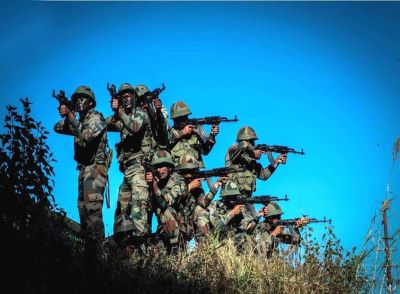Context:
● The annual media interaction with the Army Chief on January 11 serves as a critical platform to assess India's military strategic security issues. In his second and final interaction of his tenure, General Manoj Pande provided a nuanced overview of the challenges faced by the Indian Army.
● While acknowledging challenges, he expressed confidence in the Army's ability to secure the nation.
Manipur and the Indo-Myanmar Border:
General Pande acknowledged the improved situation in Manipur, highlighting collaborative efforts with central and state agencies. However, the theft of 5,000 small arms from state police armouries remains a concern, with only 30% recovered. The volatile Indo-Myanmar border complicates matters, aided by the Free Movement Regime facilitating movement without visas. The Chief expressed worry about limited Assam Rifles units available for border sealing. The need for expansion of Assam Rifles is evident, given their unique suitability for Northeast deployments.
|
About Free Movement Regime
In 2018, the Free Movement Regime (FMR) was introduced, enabling individuals living on either side of the India-Myanmar border to travel 16 km into each other's territory without the need for a visa. Those wishing to cross over are required to present a border pass valid for one year, allowing them to stay for up to two weeks.
|
The AR's alleged lack of neutrality in counter-insurgency operations and ethnic tensions in Manipur pose challenges. The potential spread of turbulence necessitates a robust, integrated approach, aligning military clarity with political and social narratives. External support concerns underscore the need for a sustainable solution beyond short-term victories.
Jammu and Kashmir:
General Pande's candid acknowledgment of the concerns in Jammu and Kashmir reflects a refreshing departure from routine responses. Recognizing the need for a fresh approach, he emphasizes learning tactical lessons from setbacks, particularly the high ratio of losses to achievements in the J&K counter-proxy campaign. The Chief's mature outlook, coupled with the Raksha Mantri's commitment to winning hearts and minds, positions the Army favorably for future endeavors.
Northern Borders with China:
The complexities of the northern borders with China along the Line of Actual Control (LAC) demand attention. General Pande assured high operational preparedness, emphasizing robust and balanced deployments. The desire to return to the status quo ante, followed by troop reduction discussions, reflects a strategic approach. The trust deficit between India and China necessitates maintaining a high state of readiness to avert misunderstandings.
|
About LAC
● The Line of Actual Control (LAC) functions as the delineation between territories under Indian administration and those under Chinese control. This boundary is segmented into three sectors: the eastern sector covering Arunachal Pradesh and Sikkim, the middle sector encompassing Uttarakhand and Himachal Pradesh, and the western sector situated in Ladakh. ● India asserts that the LAC spans 3,488 km, whereas China maintains a differing perspective, estimating it to be approximately 2,000 km in length. It's crucial to note that for India, the official claim line is represented by the boundary as depicted on maps released by the Survey of India, encompassing Aksai Chin and Gilgit-Baltistan. Consequently, the LAC does not align with India's claim line. ● On the other hand, China generally considers the LAC as its claim line, with an exception in the eastern sector where it asserts authority over the entire Arunachal Pradesh, designating it as South Tibet. |
While the risk of imminent war is low, tactical differences can escalate without careful management. The international geopolitical situation, marked by mistrust, requires the Army to stay vigilant. General Pande's emphasis on force restructuring for a two-front threat response is crucial. India's prudent approach, avoiding extremities, showcases resilience against Chinese coercion.
Future Challenges and Preparedness:
In addition to immediate security concerns, General Pande's forward-looking approach extends to preparing the force for inevitable technology transformations. Adapting to advancements is vital for staying ahead of potential adversaries. The integration of cutting-edge technologies into the Army's operational framework is imperative for future readiness.
Furthermore, the Chief must consider seemingly mundane threats, such as those posed by climate change. Acknowledging and preparing for the impact of climate change on military operations is a strategic necessity. This holistic approach ensures that the Indian Army is not only prepared for conventional challenges but also resilient in the face of evolving and unconventional threats.
Conclusion:
In conclusion, General Manoj Pande's media interaction provided valuable insights into the state of India's internal security. From Manipur's ethnic tensions to J&K's evolving dynamics and the complexities along the northern borders, the Chief's reflections highlighted a pragmatic, proactive approach. The Army's readiness to address contemporary challenges, coupled with a focus on winning hearts and minds, positions India favorably in a rapidly changing security landscape. As the nation navigates geopolitical uncertainties, the Army's resilience, adaptability, and preparedness remain pivotal in safeguarding India's sovereignty.
|
Probable Questions for UPSC Mains Exam
|
Source: Indian Express







